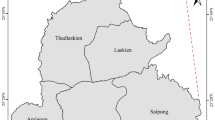Abstract
Based on the 2014 forest resource second-class investigation data and DEM data of Yabuli forest park, we used the GIS technology and Fragstats4.2 analysis software, and adopted the 2-class classification system including land-use type and dominant tree species to analyze the composition elements, patch characteristics and spatial distribution of landscapes in research area. The results are as follows:forest land, accounting for 74.5% of the total area, is the largest landscape type, followed by agricultural land which takes 11.49% of the total area; Broad leaf mixed forest (24.76%), linden forest. (17.57%), larch forest (11.83%), A. mono Maxim (11.74%) and birch (9.89%) are main landscape types in forest land, and the patches are in concentrated distribution. The distribution of the components of each landscape are affected obviously by altitude, exposure and gradient. Great differences also exist in their complexity, adjacency, reunion and fragmentation. The interference of human activities and people’s long-term forest management also have a great impact on the spatial distribution of forest landscape.
Similar content being viewed by others
References
Jianguo, W.: Landscape Ecology: Structure, Process, Measure and Level, 2nd edn. Higher Education Press, Beijing (2007)
Turner, M.G.: Spatial simulation of landscape changes in Georgia: a comparison of 3 transition models. Landsc. Ecol. 1(1), 29–36 (1987)
Nan, S., Jingmin, W., Pengxiang, Z., et al.: GIS-based analysis on forest landscape patter in Huanglongshan forest region. J. Northwest Agric. For. Uni. 9, 61–67 (2013)
Fengqin, L., Bo, C., Shaoning, L., et al.: Analysis on characteristics of forest landscapes In Badaling Shifo Temple, Beijing. Resour. Environ. Arid Areas 29(4), 149–154 (2015)
Shirong, Z., Guoshu, G., Liangji, D., et al.: Analysis on spatial pattern of hilly area landscape in Western Sichuan. J. Ecol. 23(2), 380–386 (2003)
Jibinm, W., Xiaoshuang, L., Caiwen, L.: Analsis on present status of landscape pattern in Jiange, Sichuan based on SPOT image. J. Northwest For. Coll. 29(2), 257–261 (2014)
Yadong, Z., Zhaode, Z.: Analysis on forest landscape pattern on Hainan Island based on GIS and fragstats. J. Central South Univ. For. Technol. 5, 78–83 (2015)
Ling, L., Xin, L., Guodong, C., et al.: Analysis on landscape structure in Heihe River basin. J. Ecol. 21(8), 1217–1224 (2001)
Meijuan, H., Guolin, H., Nianxing, Z., et al.: Spatial distribution pattern and multi-scale characteristics of Lushan forest landscapes. J. Ecol. 35(16), 5294–5305 (2015)
Jianbo, H., Xiaoyu, L., Chen, W.: Analysis on Shenyang Urban landscape pattern based on QuickBird and GIS. J. Ecol. 27(5), 809–815 (2008)
Yu, H., Zhang, F., Wang, J., et al.: Application of land economical ecological niche in county landscape pattern analysis: a case study of Jinghe county in Sinkiang. J. Appl. Ecol. 26(12), 3849–3857 (2015)
Bojie, F.: Analysis on agricultural landscape spatial pattern in loess area. J. Ecol. 15(2), 113–120 (1995)
Guojing, Y., Duning, X., Chengzhuo, Z.: GIS-based analysis on forest landscape pattern of Qilian mountain. Study Arid Area 21(1), 27–32 (2004)
Yongjun, W., Tuansheng, L., Kang, L., et al.: Landscape pattern analysis and segmentation evaluation for Elm area. Resour. Sci. 27(2), 161–165 (2005)
Huiru, Z., Peng, H., Pumei, L.: Analysis on forest landscape pattern in Qingyan county based on inventory for forest planning and design. J. West. For. Sci. 39(4), 1–7 (2010)
Jiaqin, Z., Hua, O., Shukui, N., et al.: Changes of landscape pattern between 1985–2000 in Tibet region and impact factor analysis. Resour. Environ. Arid Area 22(1), 139–145 (2008)
Lin, Z., Gaodi, X., Li, Y., et al.: Characters of landscape patterns and correlation in each county in Jinghe watershed. J. Ecol. 25(12), 3343–3353 (2005)
Yaoyun, D.: Coarse woods residual body reserves and spatial distribution in tropical seasonal rainforest in Xishuangbanna. J. Ecol. 31(2), 261–270 (2012)
Acknowledgements
Thanks for the precious advice on this paper provided by Hu Haibo of Najing Forestry University, Special guidance Project of the member of Heilongjiang Academy of Science XB2015SW01.
Author information
Authors and Affiliations
Corresponding author
Rights and permissions
About this article
Cite this article
He, X., Bo, Y., Du, J. et al. Landscape pattern analysis based on GIS technology and index analysis. Cluster Comput 22 (Suppl 3), 5749–5762 (2019). https://doi.org/10.1007/s10586-017-1502-3
Received:
Revised:
Accepted:
Published:
Issue Date:
DOI: https://doi.org/10.1007/s10586-017-1502-3




